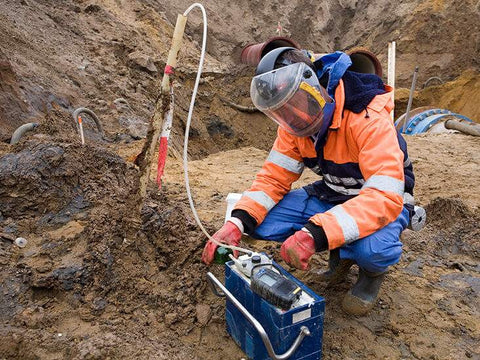
Low concentrations of different pharmaceutical drugs are advancing into our water systems and soil through improper disposal, such as flushing and human excretion.
Whenever people take antibiotics or different medications, they frequently go through the urine unchanged, dynamic, and state. This drug-containing urine, at that point, enters wastewater treatment facilities where it isn't filtered through because of an absence of screening and the important equipment required to remove the drugs.
Excrement containing pharmaceutical drugs ultimately ends up in the environment, which is concerning because the environmental effects of this procedure are not yet being revealed and are, thus, broadly unknown.
However, a new study published in the journal mBio reveals some insight into the effects of these medications, how their environmental quality contributes to antibiotic resistance, and their response to heavy metals present in nature because of common sources and human activities.
Let us examine how these two contaminants threaten the environment and humans.
Antibiotics and the environment
Antibiotics are powerful tools for battling and preventing diseases in human and animal health.
However, widespread abuse of antibiotics has brought a disturbing increase in antibiotic-resistant infections.
The Centers for Disease Control and Prevention calls antibiotic resistance one of our most genuine health threats that causes no less than 2 million illnesses in Americans every year, with 23,000 deaths.
"Antibiotic stewardship" is the way toward enhancing how antibiotics are utilized.
How the Antibiotics Enter the Environment
Most antibiotics treat infections caused by microscopic organisms or different pharmaceuticals that enter the natural environment after being used for human and animal health.
For instance, when:

-
An individual or animal is given an antibiotic, not the greater part of the drug spent inside the body. Some antibiotics are discharged in their unique form or slightly changed in urine and stool.
-
Antibiotic-containing waste from our pets ends up in landfills and neighborhood sewer runoff.
-
Antibiotics in excrement and other waste-based fertilizers keep running off products and grazing fields into waterways.
-
Antibiotics applied to fruit trees to treat bacterial diseases keep running off to fields as runoff into waterways.
-
New antibiotics are tossed into landfills or flushed down channels or toilets.
-
Like ethanol production, some industrial procedures create antibiotic-containing waste products that may add to environmental contamination.
How Environmental Antibiotics Contribute to Resistance
What we know about bacteria is that in any setting (regular, healing facility, or inside our bodies), bacteria within sight of antibiotics will attempt to change to survive.
These progressions can prompt antibiotic resistance — the ability of bacteria to withstand antibiotic impacts.
Bacteria can likewise pass on the ability to resist antibiotic effects by sharing hereditary instructions (protection qualities) with other bacteria in water and soil.
However, there are questions we must ask ourselves and things we need to know.
Do antibiotics, antibiotic-resistant bacteria, and resistance genes in the environment put individuals and animals directly in danger of resistant infections?
Do environmental sources of antibiotics, resistant bacteria, and resistance genes make the battle against antibiotic resistance harder?
Things to Do to Keep Antibiotics Out of Water
• Avoiding diseases can decrease the need for antibiotics. Wash your hands properly, cover your cough, and get suggested vaccines.
• Do not request antibiotics if your healthcare provider, dentist, or veterinarian thinks they are unnecessary.
• When you are prescribed antibiotics, take them precisely as directed.
• Only take antibiotics prescribed for you; don't share or use leftover antibiotics. Antibiotics treat particular infections, and taking the wrong medication may exacerbate the situation.
•Do not spare antibiotics work for your next illness. Properly dispose of any leftover medication once the recommended course of treatment is finished.
Heavy Metals and the Environment

Heavy metals constitute an extremely heterogeneous group of elements that generally differ in chemical properties and biological functions.
Heavy metals are classified as environmental pollutants because of their dangerous impacts on plants, animals, and people.
Soil contamination by heavy metals results from anthropogenic and natural activities.
Anthropogenic activities, such as mining, smelting operations, and agriculture, have locally increased the levels of heavy metals, such as Cd, Co, Cr, Pd, As, and Ni, in soil to dangerous levels.
Heavy metals are persistent. In this manner, they accumulate in soils and plants. Dietary intake of numerous heavy metals through the consumption of plants has long-term detrimental effects on human health.
Heavy metals affect aquatic life by causing pollutants to develop from various diffuse or point sources, which can lead to coincidental mixtures in the ecosystem.
Hence, it represents an extraordinary danger to aquatic fauna, particularly to fish, which constitute one of humankind's real wellsprings of protein-rich sustenance.
The Contamination Sources:
Tetraethyl lead (CH3CH2)4Pb is likely the most important heavy metal contaminant in recent use. Heavy metals are generally discovered on the earth and are concentrated because of anthropogenic activities.
Regular sources are from mining, mechanical squander vehicle outflows, lead-corrosive batteries, composts, paints, and treated woods.
Lead is the most common heavy metal contaminant. As a part of the tetra-ethyl lead, it was utilized widely in gas amid the 1930s-1970s.
Lead levels in the aquatic conditions of industrialized societies have been assessed to be a few times those of pre-modern levels; even though leaded gas was greatly eliminated in North America by 1996, soils beside streets that worked before this time held high concentrations of lead.
The Entry Routes
Heavy metals enter plant, animal, and human tissues through inhalation, diet, and manual handling.
Motor vehicle emissions are a major source of airborne contaminants, including arsenic, cadmium, cobalt, nickel, lead, antimony, vanadium, zinc, platinum, palladium, and rhodium.
Heavy metals leaching from industrial and consumer waste can also contaminate water sources (groundwater, lakes, streams, and waterways); acid rain can exacerbate this process by releasing heavy metals trapped in soils.
Plants are exposed to heavy metals through water uptake; animals eat these plants; ingesting plant- and animal-based foods are the sources of heavy metals in people.
Absorption through skin contact with soil is another potential wellspring of overwhelming metal sullying. Heavy metals, which are difficult to utilize, can be collected in life forms.
The Detrimental Effects
Heavy metals "can bind to vital cellular components, such as structural proteins, enzymes, and nucleic acids, and interfere with their functioning."
Broadly, long-term exposure to heavy metals can have carcinogenic central and peripheral nervous systems and circulatory effects.
The table shows typical human presentations associated with exposure to the "classical" heavy metals, chromium (another heavy metal), and arsenic (a metalloid).
The Metal Toxicity
Metal toxicity or poisoning is the toxic effect of specific metals in specific structures and dosages on life. Some metals are harmful when they form poisonous soluble compounds.
Certain metals have no biological role; they are not basic minerals or are lethal when in a specific shape. In the case of lead, any measurable amount may have negative health impacts.
Heavy metals are frequently considered synonymous. However, lighter metals, such as beryllium and lithium, such as beryllium and lithium, may be harmful in specific conditions.
Metals now sometimes eat the activity of a basic element in the body, meddling with the metabolic procedure to cause disease. Many metals, particularly heavy metals, are toxic.
However, some heavy metals are essential, and a few, such as zinc, have low toxicity.
The Hazards of Heavy Metal Contamination
Lead, cadmium, mercury, and arsenic are the main threats to human health from heavy metals. These metals have been widely considered, and their consequences for human health are consistently assessed internationally, for example, by the WHO. People have utilized heavy metals for a great many years.
Although several adverse health effects of heavy metals have long been known, their presence has expanded in a few regions, specifically in less developed nations. However, emissions have declined in most developed nations over recent years.
Cigarette smoking is a major source of cadmium exposure. In non-smokers, food is the most important source of cadmium introduction.
Recent data indicate they demonstrate that adverse health effects of cadmium exposure may occur at lower exposure levels than previously anticipated, primarily in the form of kidney damage but possibly also bone effects and fractures.
Long-term exposure to arsenic in drinking water is predominantly identified with expanded dangers of skin cancers. Additionally, skin lesions, such as hyperkeratosis and pigmentation, change. Clear exposure reaction relationships and high risks have been observed.
Toxic Heavy Metals Can Cause the Following Health Problems
-
Low exposure to chromium can irritate the skin and cause ulceration. Long-term exposure can damage the kidneys, liver, and circulatory and nerve tissues.
-
Long-term exposure to cadmium is associated with renal dysfunction. Cadmium is persistent and, once absorbed, remains in the body for many years. High exposure can lead to obstructive lung diseases and has been linked to lung cancer. Cadmium may also cause bone defects in humans and animals.
-
Monomethyl mercury causes damage to the brain and the central nervous system. At the same time, fetal and post-natal exposure has given rise to abortion, congenital malformation, and development changes in young children. Exposure to high levels of arsenic can cause death. All types of arsenic exposure can cause kidney and liver damage, and in the most severe exposure, there is erythrocyte hemolysis.
-
Aluminum toxicity is associated with the development of bone disorders, including fractures, osteopenia, and osteomalacia.
-
Excessive nickel can be mildly toxic. Long-term exposure can cause decreased body weight, damage to the heart and liver, and skin irritation.
-
Manganese is known to block calcium channels and, with chronic exposure, results in CNS dopamine depletion. This duplicates almost all of the symptomology of Parkinson’s disease.
-
High doses of copper can cause anemia, liver and kidney damage, and stomach and intestinal irritation.
Role of the Combinations of Low Levels of Antibiotics and Heavy Metals in Resistant Bacteria
Swedish researchers led the examination to examine how low groupings of single antibiotics and heavy metals, or combinations of the mixes, can choose for plasmids that convey protection from the two antibiotics and heavy metals like silver, copper, and arsenic.
The examination found that plasmids (small, twofold-stranded DNA particles particular to a cell's chromosomal DNA) containing genes that carry antibiotic resistance can be "enriched by very low concentrations of antibiotics and heavy metals. "
Researchers say this phenomenon supports the suspicion that antibiotic residues and heavy metals in the environment add to "problems of resistance."
Plasmids are becoming resistant to antibiotics, biocides, and heavy metals. "Biocides are chemicals used to suppress organisms that are harmful to human or animal health, or that cause damage to natural or manufactured materials," according to the European Commission. Some examples of biocides are insect repellants, industrial chemicals, and disinfectants.
Antibiotics and Biocides Reduction to Suppress Resistant Bacteria
To achieve their decision, researchers performed "sensitive competition experiments" that included permitting two distinct strains of bacteria, one susceptible to antibiotics and one resistant with a plasmid, to become together in a culture with little measures of antibiotics and heavy metals present.
The study's results indicate that low concentrations of heavy metals (such as arsenic) and antibiotics, independently or in combination, could enhance the resistance of plasmid-bearing bacteria.
This most recent scientific discovery debate claims that low convergences of pharmaceutical medications on the earth are safe; truth be told, their transformative capacities have ended up being very unsafe.
Ways on How To Preventing Environmental Contamination
To ensure the environment stays protected and provide a safe and healthy atmosphere for future generations, each individual must do their part in preventing the pollution that humans are mostly responsible for.
Preventing pollution is an easy habit to incorporate into daily actions. Below are a few ways to protect our environment from contamination, such as heavy metals or antibiotics.

a) Conservation:
Saving energy and modifying wasteful habits is a great way to prevent pollution. There are many different ways to approach this pollution prevention method, as alternate fuel options, clean fuels, energy efficiency tactics, and fuel economy are just some of the options an individual may consider.
b) Pollution Prevention Programs:
Every state possesses its own set of prevention programs geared towards lessening the damaging effects of pollution on a local and statewide level. This may include various recycling methods and options, such as battery recycling centers, composting education, recyclable electronics, glass recycling, onsite and offsite paper recycling, recycling plastics, refrigerant recycling, tire salvaging, and used oil recycling.
c) Choose Native Landscaping:
When planting trees, shrubs, flowers, and other plants, it is suggested to choose native options that do not require fertilizers and pesticides.
d) Waste Reduction:
The minimization of waste helps to prevent the growth of the global pollution problem. This may include switching to energy-saving products or minimizing the time you leave your lights on in the house. You may also recycle juice boxes, newspapers, milk cartons, and tin cans.
← Older Post Newer Post →
